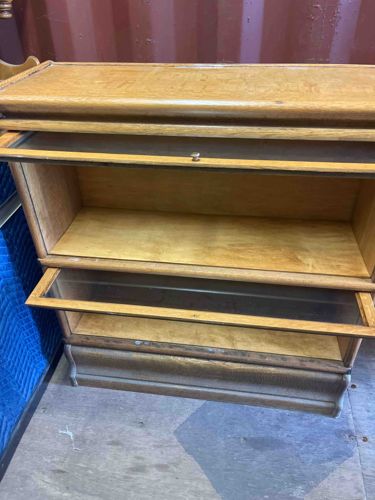
Sectional Barrister Bookcase Unit
This appears to be a vintage 'barrister' or 'sectional' bookcase, typically made with stackable units. The visible sections are constructed from what appears to be light-colored oak or a similar hardwood, exhibiting visible wood grain throughout. Each section features a hinged, upward-rolling glass door, often referred to as a 'fall-front' or 'up-and-over' mechanism, designed to slide back into the top of the shelf when opened. The top unit shown has a solid, flat surface, suggesting it is either the topmost section or a standalone piece. The lower section features a molded base, indicating it is likely the bottom-most unit of a larger stack. The wood exhibits a warm, medium-tone finish that has likely mellowed over time, showing a natural patina. There are some signs of wear and tear, including scuffing and discoloration on the edges and surfaces, particularly on the base molding and around the glass doors. The glass in the doors appears intact. One small, round metal knob is visible on the upper glass door, serving as a handle. The construction appears sturdy, suggesting solid wood craftsmanship, characteristic of early 20th-century office or library furniture. No specific maker's marks or signatures are discernible from the provided image. The overall style points to an Arts and Crafts or Mission Revival influence, popular from the late 19th to mid-20th century. The 'Pathe' and 'Colyears' context might suggest a commercial or institutional origin for this type of furniture, possibly used in offices, libraries, or retail establishments associated with these entities. The internal compartments are open and ready for storage.
AI-Generated Appraisal Disclaimer
Estimated Value
$600-900
Basic Information
Category
Furniture
Appraised On
December 7, 2025
Estimated Value
$600-900
Additional Details Provided By Owner
User Provided Information
Pathe, Colyears
Item Description
This appears to be a vintage 'barrister' or 'sectional' bookcase, typically made with stackable units. The visible sections are constructed from what appears to be light-colored oak or a similar hardwood, exhibiting visible wood grain throughout. Each section features a hinged, upward-rolling glass door, often referred to as a 'fall-front' or 'up-and-over' mechanism, designed to slide back into the top of the shelf when opened. The top unit shown has a solid, flat surface, suggesting it is either the topmost section or a standalone piece. The lower section features a molded base, indicating it is likely the bottom-most unit of a larger stack. The wood exhibits a warm, medium-tone finish that has likely mellowed over time, showing a natural patina. There are some signs of wear and tear, including scuffing and discoloration on the edges and surfaces, particularly on the base molding and around the glass doors. The glass in the doors appears intact. One small, round metal knob is visible on the upper glass door, serving as a handle. The construction appears sturdy, suggesting solid wood craftsmanship, characteristic of early 20th-century office or library furniture. No specific maker's marks or signatures are discernible from the provided image. The overall style points to an Arts and Crafts or Mission Revival influence, popular from the late 19th to mid-20th century. The 'Pathe' and 'Colyears' context might suggest a commercial or institutional origin for this type of furniture, possibly used in offices, libraries, or retail establishments associated with these entities. The internal compartments are open and ready for storage.
Get Your Items Appraised
Instant estimates of your treasures with AI-powered instant appraisals